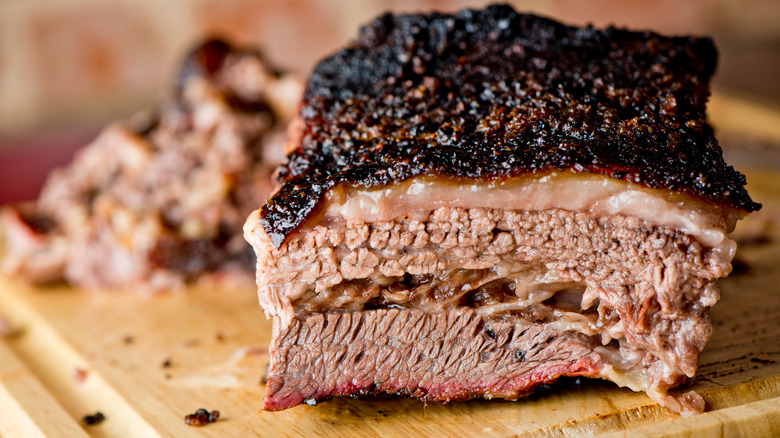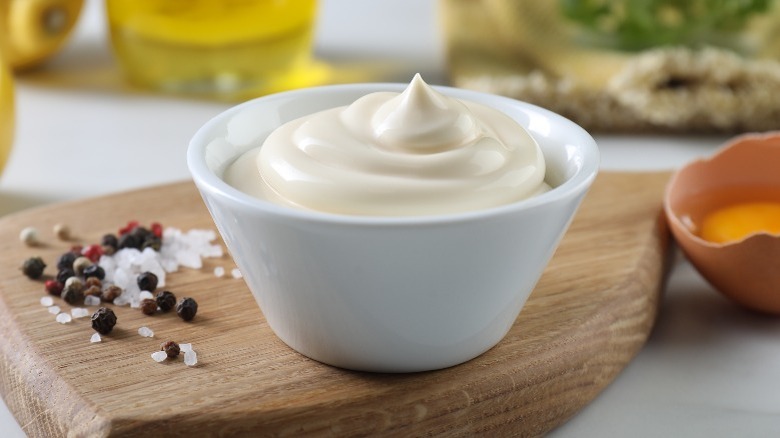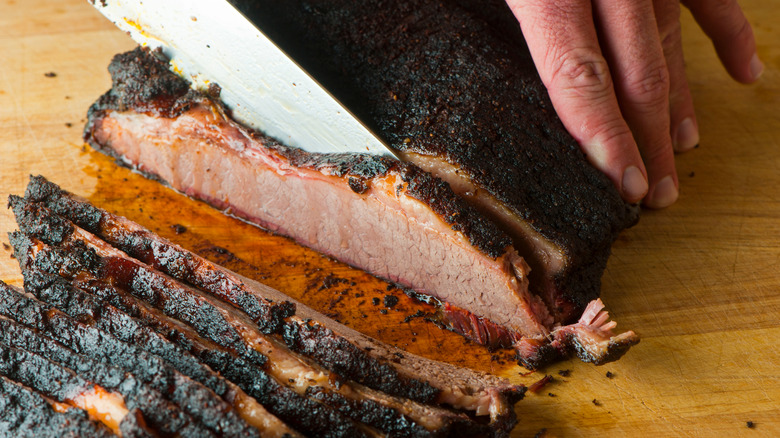The Slept-On Binder Ingredient For Unbeatable Brisket
Brisket is the star of many a backyard barbecue. When it's done right, the beef preparation is tender and juicy, with a flavorful crust that adds just a little crunch. But all those beloved brisket elements don't happen on their own — for one, brisket needs a particular cooking method to get the texture right. Found on the front breast of a cow, brisket is a muscular cut with lots of tissue and fat, so it has to cook at a low temperature for a long time in order to turn out tender. The low temperature and lengthy cooking time help break down some of that fat and tissue, keeping the cut from staying tough.
Even though the cooking method is part of the crust equation, getting that signature bark on the outside of the meat starts before you even begin barbecuing. This tasty layer is made up of the meat's moisture and the added seasonings — giving lots of extra flavor as well as a crispy outer texture. But there's another key ingredient that keeps all of that in place: a binder. And even though this advice may divide the room, slathering your barbecued beef brisket in mayonnaise is the perfect way to bind and build an unbeatable brisket bark.
Why your brisket needs a mayo binder
Cool your condiment outrage until the mayo case is made. A binder is used on meats to make sure all the dry seasonings stay in place — simply put, it's a sticky layer holding everything together. If you're using a dry rub (i.e. a mix of dry herbs, spices, and other seasonings) for your brisket, you may find that the seasoning has trouble sticking once it begins to cook. It's a frustrating situation to open your smoker, especially given how long it takes to smoke a brisket, only to find all that brisket flavoring has fallen off. The binder acts as a, well, binding agent to hold the dry seasonings to the meat, allowing them to brown as the meat cooks and form the bark.
You may have your own heated opinions about mayonnaise as a condiment (your cries of "keep it away from my sandwiches" are coming through the screen), but as a brisket binder, it's a top-notch, under-utilized choice. All you need is a thin layer covering the meat — once cooked, the mayo flavor won't come through at all, only a silky, tangy richness. It also adds a little moisture of its own to help the brisket come out even more tender, and mayo is an excellent binding agent to keep meat moist because the layer holds the brisket's natural moisture in.
If you don't have mayo, here's what else you can try
Mayonnaise is a great choice for a binder that not only has a mild, mostly neutral flavor when cooked but also has ideal moisture properties. But if you don't have any mayonnaise on hand (or your aversion to it is just too strong), there are other binders you can test out. Mustard is a common binder because its flavors are generally complementary to the spices used for rubs, but you can also use olive oil or canola oil for a binder that won't give off its own taste. Even water can be used in a pinch, but it won't be nearly as sticky as a thicker choice.
If mayonnaise's mildness is what's putting you off, you can always mix it with another binder, such as mustard, vinegar, or hot sauce, that will have a stronger flavor. That way, you'll still get the benefits of mayo's silky, tangy, moisture-locking, spice-adhering properties while another binder shines on the flavor side. Mayo and barbecue meat may not seem like a natural marriage, but once you try it on your brisket and taste the bark that forms, you'll never go back.


